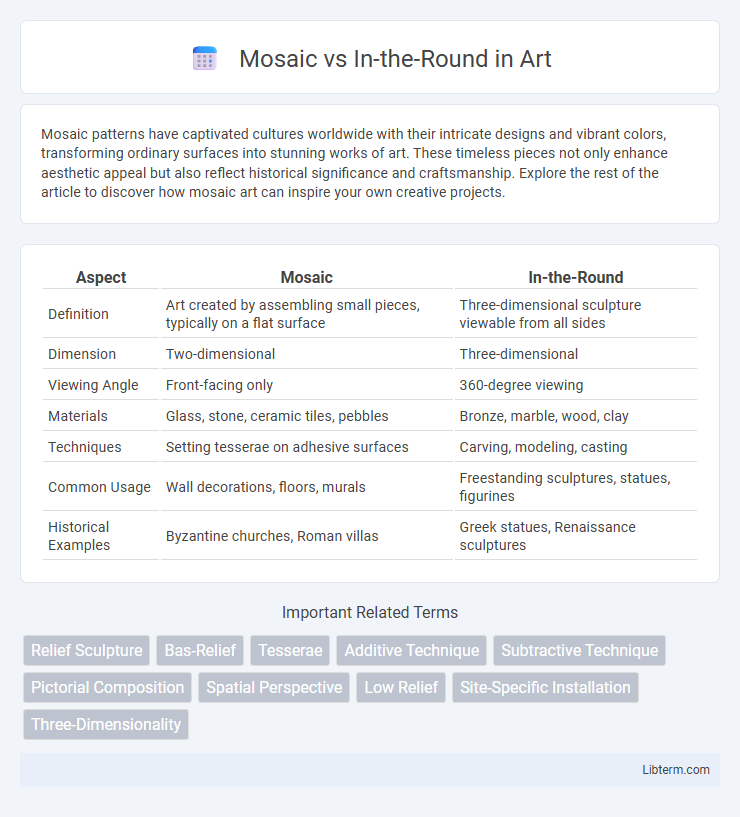Mosaic patterns have captivated cultures worldwide with their intricate designs and vibrant colors, transforming ordinary surfaces into stunning works of art. These timeless pieces not only enhance aesthetic appeal but also reflect historical significance and craftsmanship. Explore the rest of the article to discover how mosaic art can inspire your own creative projects.
Table of Comparison
| Aspect | Mosaic | In-the-Round |
|---|---|---|
| Definition | Art created by assembling small pieces, typically on a flat surface | Three-dimensional sculpture viewable from all sides |
| Dimension | Two-dimensional | Three-dimensional |
| Viewing Angle | Front-facing only | 360-degree viewing |
| Materials | Glass, stone, ceramic tiles, pebbles | Bronze, marble, wood, clay |
| Techniques | Setting tesserae on adhesive surfaces | Carving, modeling, casting |
| Common Usage | Wall decorations, floors, murals | Freestanding sculptures, statues, figurines |
| Historical Examples | Byzantine churches, Roman villas | Greek statues, Renaissance sculptures |
Understanding Mosaic Composition
Mosaic composition involves assembling smaller, varied pieces into a unified image, emphasizing flat surfaces and intricate patterns that create depth through color and texture contrasts. In-the-round art differs by presenting a three-dimensional form viewable from all angles, focusing on volume, spatial relationships, and physical presence. Understanding mosaic composition requires analyzing how individual tesserae contribute to the overall visual effect, integrating both artistic intent and technical precision.
Defining In-the-Round Art Technique
In-the-round art technique refers to sculptures or artworks that are fully three-dimensional and viewable from all angles, allowing observers to engage with the piece in a 360-degree space. Unlike mosaics, which are typically two-dimensional and created by assembling small pieces of glass, stone, or tile on a flat surface, in-the-round artworks emphasize volume, form, and spatial presence. This technique is essential in classical sculpture, where artists like Michelangelo crafted lifelike figures that can be seen and appreciated from every perspective.
Historical Development of Mosaic and In-the-Round
Mosaic art originated in ancient Mesopotamia and flourished in the Byzantine Empire, characterized by assembling small, colored pieces of glass or stone to create intricate images on walls and floors, symbolizing religious and cultural narratives. In-the-round sculpture, emerging prominently in ancient Greece and Rome, involves fully three-dimensional figures crafted to be viewed from all angles, highlighting realistic human anatomy and dynamic movement. Both art forms evolved to reflect societal values and technological advancements, with mosaic preserving flat, decorative storytelling and in-the-round emphasizing lifelike representation.
Key Visual Differences Between Mosaic and In-the-Round
Mosaic artwork typically features flat, two-dimensional surfaces composed of small, colored pieces of glass, stone, or tile arranged to create intricate patterns or images. In contrast, In-the-Round sculptures are fully three-dimensional and designed to be viewed from all angles, emphasizing depth, volume, and spatial interaction. Key visual differences include the mosaic's emphasis on surface texture and color contrast versus the sculptural roundness and dynamic form characteristic of In-the-Round works.
Materials and Tools Used in Each Technique
Mosaic art primarily uses small pieces of glass, stone, or ceramic called tesserae, combined with adhesives and grout to create intricate images or patterns on flat surfaces. In-the-round sculpture involves carving or modeling materials like marble, wood, clay, or bronze to create three-dimensional forms viewable from all angles. Tools for mosaics include nippers, tweezers, and spatulas, while in-the-round sculpting requires chisels, rasps, modeling tools, and casting equipment.
Artistic Applications: Where Mosaic Excels
Mosaic art excels in detailed, durable surface decoration ideal for architectural embellishments and public art installations, offering vibrant color permanence and tactile texture. It is especially effective in large-scale projects such as murals, floors, and outdoor environments where weather resistance and longevity are critical. The medium's adaptability to intricate geometric patterns and symbolic storytelling enhances its unique appeal in both historical and contemporary artistic applications.
Artistic Applications: Advantages of In-the-Round
In-the-round sculptures offer unmatched artistic versatility, allowing viewers to engage with the artwork from multiple perspectives, enhancing spatial interaction and emotional impact. This technique facilitates dynamic compositions that invite physical movement, creating an immersive experience impossible with flat mosaic designs. In-the-round artworks also enable intricate detailing and three-dimensional storytelling, broadening creative expression beyond the constraints of two-dimensional surfaces.
Preservation and Longevity Factors
Mosaic art, composed of small, durable tesserae often made from stone, glass, or ceramic, demonstrates exceptional preservation and longevity due to its resistance to environmental factors like moisture and temperature fluctuations. In-the-round sculptures, typically carved from marble or cast in bronze, require careful maintenance to prevent weathering, corrosion, or physical damage, affecting their long-term durability. Preservation strategies for mosaics emphasize secure substrate adhesion and grout integrity, while in-the-round artworks benefit from protective coatings and controlled display environments to enhance longevity.
Choosing the Right Technique for Your Project
Mosaic art offers intricate tile assembly techniques ideal for detailed, vibrant surfaces, while in-the-round sculpture provides a fully three-dimensional form suited for dynamic spatial interaction. Choose mosaic for wall-sized or decorative projects requiring flat, durable artistry, and in-the-round for standalone sculptures allowing 360-degree viewing. Assess your project's spatial context, material durability, and desired visual impact to determine the optimal method.
Future Trends in Mosaic and In-the-Round Art
Future trends in mosaic art emphasize the integration of digital technologies and sustainable materials, transforming traditional methods with interactive and eco-friendly elements. In-the-round art continues to evolve through the use of augmented reality (AR) and 3D printing, enabling artists to create more immersive and customizable sculptures. Both mediums are converging towards multidisciplinary collaborations, blending tactile craftsmanship with innovative digital design to expand creative possibilities.
Mosaic Infographic

 libterm.com
libterm.com